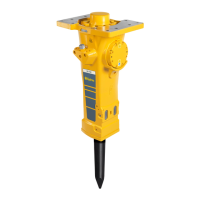Why won't my Epiroc Construction Equipment hydraulic breaker start?
- MMaria MillerJul 27, 2025
If your Epiroc Construction Equipment's hydraulic breaker doesn't start, several issues could be the cause. First, ensure the pressure and tank hoses are correctly connected and not mixed up. Next, check if any shut-off valves in the pressure or tank hoses are closed and open them if necessary. Also, inspect the couplings for defects that might be blocking the hoses; replace any defective coupling valves. Furthermore, verify that the operating pressure isn't too low by checking the carrier engine speed, pump delivery, and pressure relief valve, adjusting settings or replacing parts as needed. Finally, high return pressure can also prevent starting, so check and lower it if necessary.


